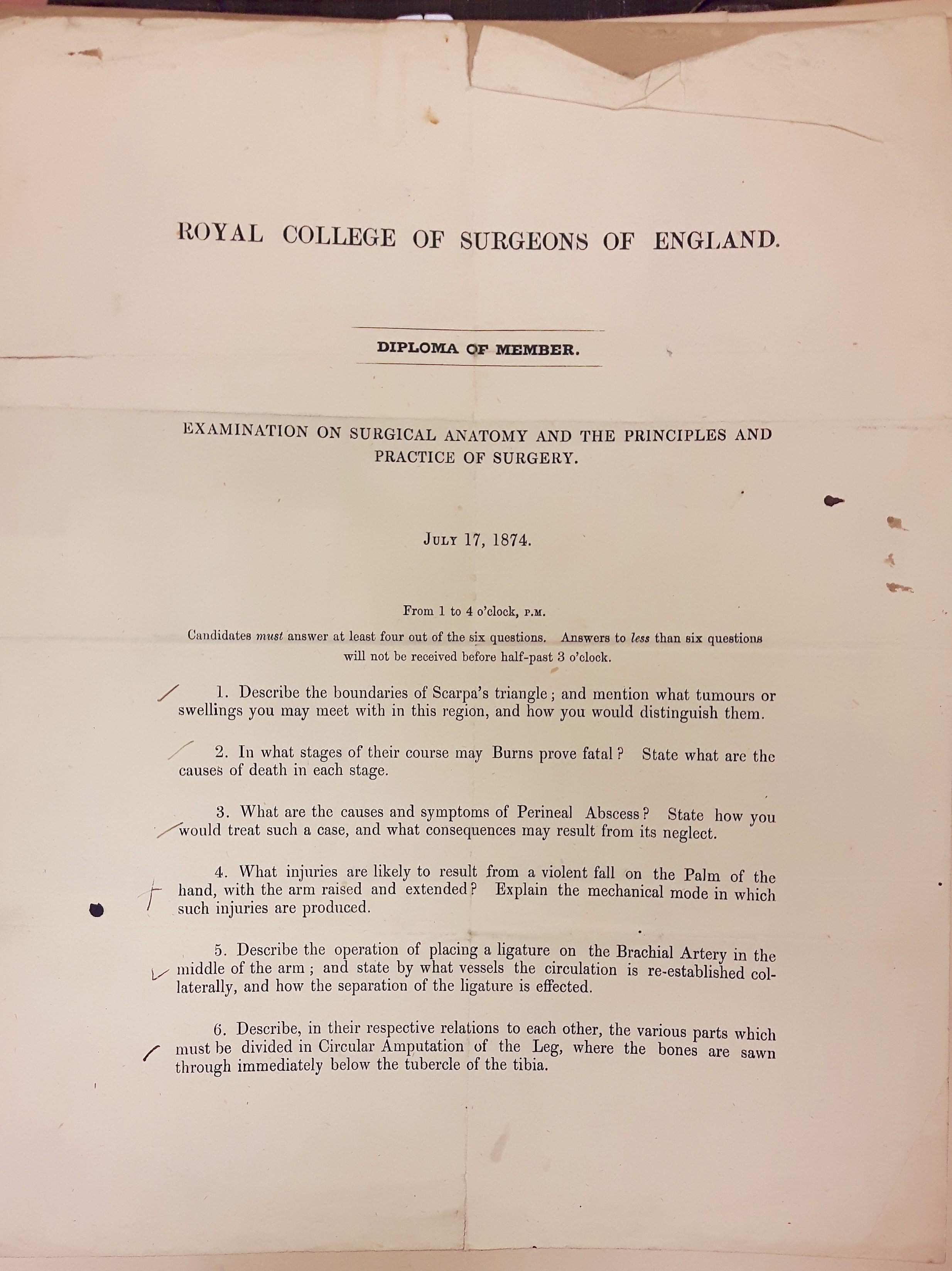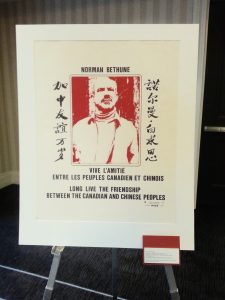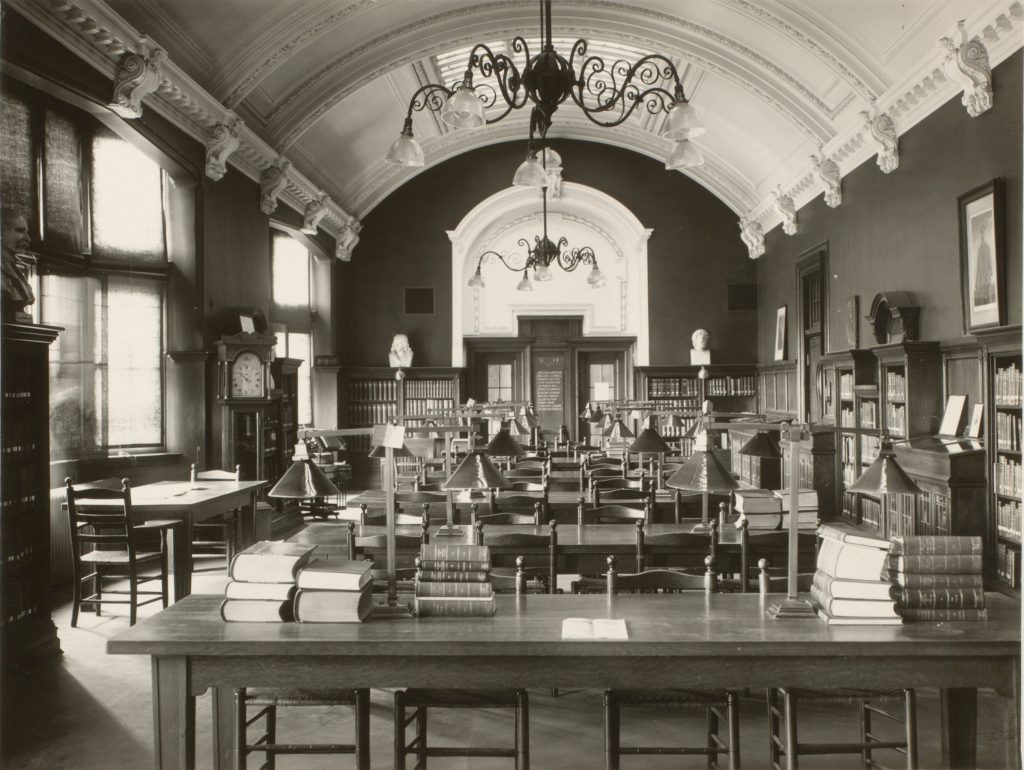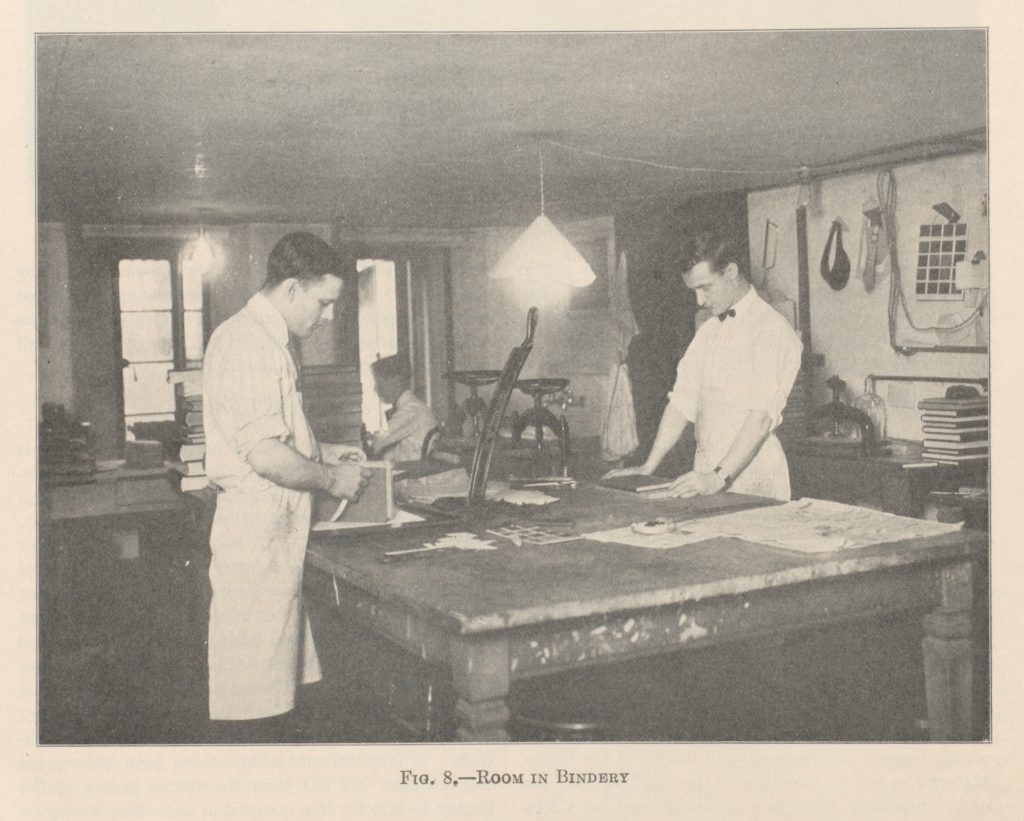Ever wondered what a medical exam from 1874 would look like? Here’s an original copy of The Royal College of Surgeons 1874 final exam on “Surgical Anatomy and the Principles and Practice of Surgery”. Students were allocated three hours to answer 4 out of 6 questions. How do you think you would fare? Would you get top marks on this? Comments are welcome.
Category Archives: collections
Remembrance: Our Girls in Wartime & Our Hospital ABC
 On November 11th, we remember.
On November 11th, we remember.
We remember as a nation all the brave men and women who left their beloved homes and chose to fight for our peace, and our freedoms.
We commemorate this Remembrance Day with two World War I children’s books in our collection by Hampden Gordon & M. C. Tindall (verses), Joyce Dennys (illustrations) and invite you to come see them in our reading room:
- Our Hospital Anzac British Canadian published ca. 1916
- Our Girls in Wartime published ca. 1917.

Our Hospital ABC. Gordon, Hampden, Tindall, M. C.; Dennys, Joyce (illus.). London: John Lane the Bodley Head, n.d. [ca. 1916]

Out Girls in Wartime. Gordon, Hampden; Dennys, Joyce (illus.). London: John Lane The Bodley Head, n.d. [ca. 1917]
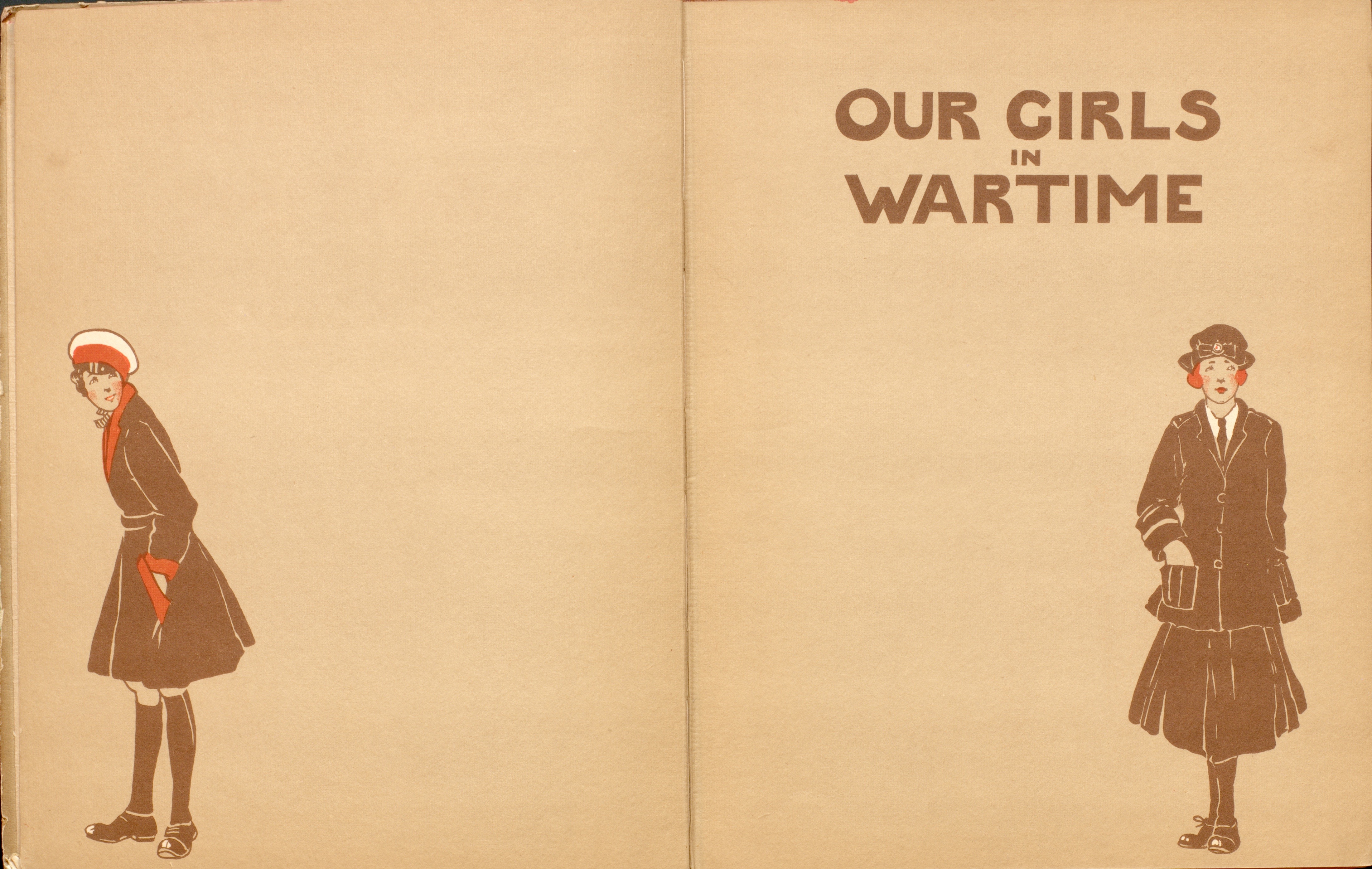
A Collaborative Exhibit for the Chinese Premier
Last month it was our pleasure to work in collaboration with McCord Museum and Bibliothèque et Archives nationales du Québec (BAnQ) on a private exhibition for Chinese Premier Li Keqiang during his visit to Montreal. The combined curatorial effort resulted in a showcase of items with historical ties and strong cultural connections between Québec and China. The exhibit included maps, photographs, books, posters, and artifacts, with a particular emphasis on the great physician Norman Bethune — a McGill graduate and well-known Canadian hero in the People’s Republic of China.

Chinese Premier Li Keqiang (centre) views the exhibit with Osler Librarian Chris Lyons (front left) and Quebec Premier Philippe Couillard (back). The Globe and Mail, Saturday Sepetember 24, 2016. Photo credit: Paul Chiasson/The Canadian Press.
We welcome and look forward to more collaborative exhibits like this one in the future!
Alibert & Early French Dermatology
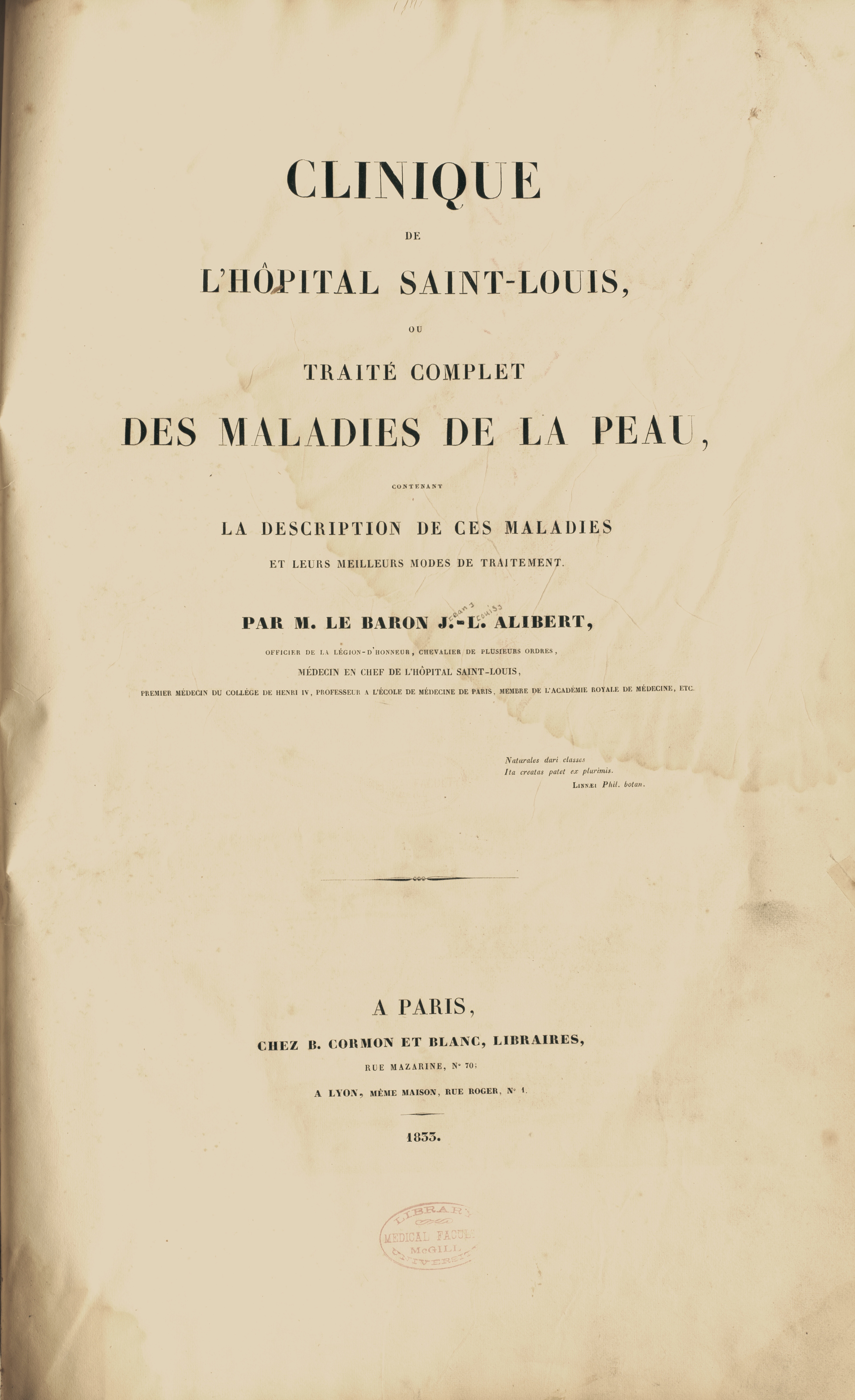
Clinique de L’Hopital Saint-Louis, de Traite Complet Des Maladies de la Peau, 1833. Unfortunately some evidence of water damage is visible, possibly from the 1907 fire.
France’s first dermatologist, Jean-Louis Alibert (1768-1837), was professor and chief-surgeon at Saint-Louis Hospital in Paris. His medical achievements and reputation as a great teacher of hospital clinics put him in the company of other influential nineteenth century physicians, collectively known as the Paris School.
Osler Library’s rare book collection houses approximately a dozen titles of Alibert’s prolific work, including three copies of his second atlas entitled Clinique de L’Hôpital Saint-Louis, de Traite Complet Des Maladies de la Peau – two 1833 French copies, and an 1835 Italian translation. The atlas is an impressive work from both a medical and an artistic standpoint. It includes 63 hand coloured plates, including the botanically-inspired “Arbe des Dermatoses” (“Tree of Dermatology”).
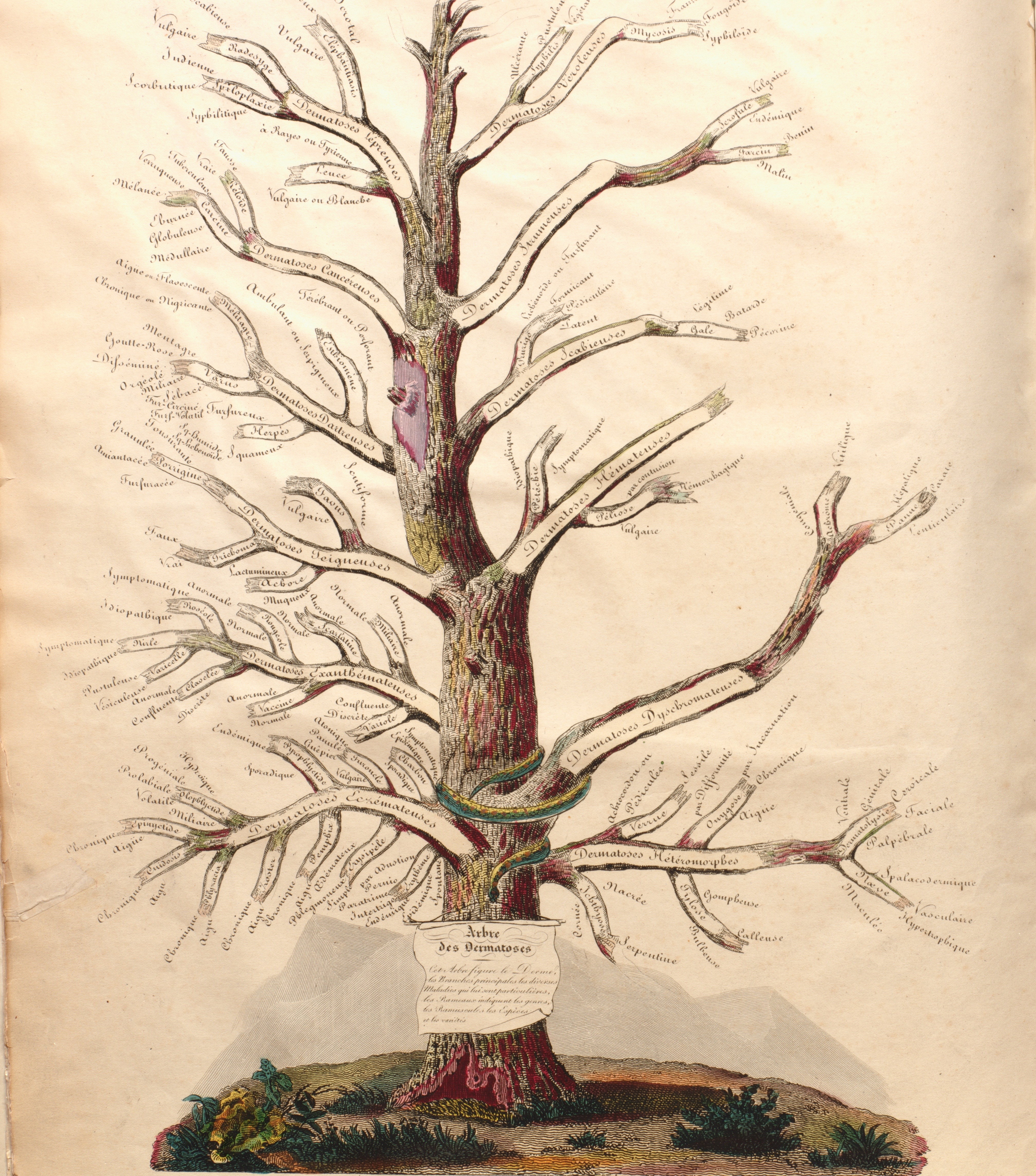
“Arbre des Dermatoses” (“Tree of Dermatosis”) shows Alibert’s method to visually classify common skin diseases and disorders with twelve main branches, each representing a class of dermatosis.
Similar to other areas of science, medical research and the practice of medicine experienced rapid progression after the French Revolution (1789-1799). Newly implemented ideological and institutional reforms allowed physicians to focus on the greater health of the whole community, allowing for the opening of clinics for the general public. It was the dawning of the “medical gaze“ – a term coined by Michel Foucault in his 1963 book The Birth of the Clinic: An Archaeology of Medical Perception.
Alibert’s clinical lessons became well-known and attracted students and physicians alike to l’Hôpital Saint-Louis. Over the course of his career, Alibert was able to make important contributions to descriptions including lupus vulgaris, keloid, dermatolysis, mycosis fungoides, and cutaneous leishmaniasisis. He is also credited with several first descriptions – among them Mycosis fungoides (shown below). This book and others by Alibert are available to view in the Osler Library’s pre-1840 room during regular opening hours.
- Pl. 50 “Mycosis fungoides”, first called Pian fungoides, 1833.
- Pl. 12 “Scarlatine Normale”, 1833.
- Pl. 31 “Mélitagre aigue ou flavescente”, 1833.
- Pl. 55 “Gale légitime, ou vésiculeuse”, Scabies, 1833.
Winter Session 1878-1879
Think you’ve got a busy schedule this semester? Here’s what Winter Session 1878-1879 looked like for McGill’s Faculty of Medicine. The course schedule shown below belonged to Sir William Osler – Professor of Physiology, General Pathology, Histological & Physiological Demonstration (1st and 2nd year) and Pathological Demonstration that year. This historical piece of mcgilliana is part of our P100 collection – a collection that recently received a handful of new acquisitions generously donated from an Osler family relative (more on these new acquisitions coming soon!).
Instructors (listed in alphabetical order): Dr. Buller, Professor Craik, Professor Dawson, Professor Fenwick, Professor Gardner, Professor Godfrey, Professor Howard, Dr. MacDonnell, Professor McCallum, Professor Osler, Professor Roddick, Professor Ross, Professor Scott, Dr. Shepherd, & Professor Wright.
Courses (listed in no particular order): Anatomy, Hygiene, Medical Jurisprudence, Ophthalmic Clinic, Botany, Surgery, Practical Chemistry, Pathological Demonstration, Midwifery, Clinical Medicine, Clinical Surgery, Materia Medica, Histological & Physiological Demonstration, Physiology, General Pathology, Practice of Medicine, Chemistry, & Practical Anatomy.
Matriculation, 150 Years Ago
As students and faculty at McGill begin a new academic year this week, we thought we’d offer a historic glimpse into what matriculation looked like 150 years ago. The leather case shown below belonged to pioneering Canadian pediatrician, Dr. Alexander Dougall Blackader (1847-1932). It was used to contain his many matriculation and membership cards from his student days at McGill from 1866-1871. In those days, students were provided with official cards for each course, in addition to their McGill ID/matric and faculty cards.
Several years after graduation, Blackader joined McGill’s Faculty of Medicine as Instructor of Diseases of Children and eventually became Professor of Pediatrics and Acting Dean from 1915-1918. As one of the first physicians in North America to insist that diseases of children needed to be recognized as a specialty, Blackader was an instrumental figure in organizing Canada’s first pediatric clinic at the Montreal General Hospital. Over the years, Blackader held several positions at MGH before retiring and becoming editor of the Canadian Medical Association Journal. The Osler Library houses a collection of Blackader’s personal and professional material including papers, lectures, autobiographical notes and diaries (P093). Here’s to a great 2016-17!
Aequanimitas
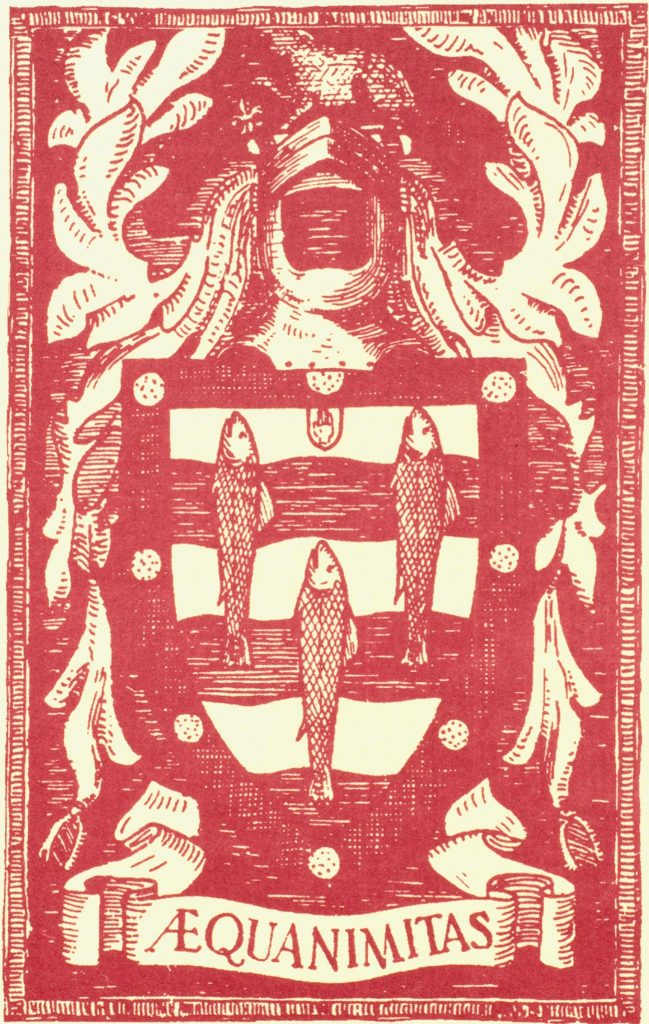 Aequanimitas — a term that derives from late-15th century Latin — means imperturbability, or one who is incapable of being upset, or agitated; one who is calm, and not easily excited.
Aequanimitas — a term that derives from late-15th century Latin — means imperturbability, or one who is incapable of being upset, or agitated; one who is calm, and not easily excited.
William Osler’s Valedictory address entitled Aequanimitas was first presented at the University of Pennsylvania, May 1st, 1889. In this short speech, Osler advised imperturbability as one of two essential qualities of the physician and of the surgeon. He defined this quality as a coolness and presence of mind under all circumstances, calmness amid storm, clearness of judgement in moments of peril, immobility, and impassiveness. The second quality he spoke of, equanimity, was described as being the mental and physical equivalent of the first.
It has been said that ‘in patience ye shall win your souls,’ and what is this patience but an equanimity which enables you to rise superior to the trials of life? Sowing as you shall do beside all waters, I can but wish that you may reap the promised blessings of quietness and of assurance forever, until
Within this life,
Though lifted o’er its strife;
you may, in the growing winters, glean a little of that wisdom which is pure, peaceable, gentle, full of mercy and good fruits, without partiality and without hypocrisy.
For those interested in reading the full address and others made by Sir William Osler, we have several regular loan copies and various translations listed in the Classic Catalogue, in addition to rare and archived materials that are part of the Osler Library Archives collection.
Old School
Harking back to simpler times, these colourful vintage volumes are from The New Canadian Health Series – a series of educational health books published in Canada during the 1950s.
A handful of these health guides, including the American ABC Health Series (pictured below) can be found in the Osler Library’s collection, available to view upon request. Acquired by the library in 2013 upon the closure of McGill’s Education Library, these volumes act as little time capsules of everyday health information and provide a fascinating retro-read of popular medicine through the eyes of mid-20th century North American culture.
New / Old
1907 was a fiery year in McGill’s history. On April 5th, the Macdonald Engineering building was completely gutted by fire, and less than a fortnight later on April 16th, the first Medical Faculty building (erected 1872) went up in flames, destroying the Medical Library (founded 1823) and the first Medical Museum curated by Maude Abbott.
The Strathcona Building – now known as Strathcona Anatomy & Dentistry – was built in its place, opening its doors in 1909. It became known as the New Medical Building and housed the Medical Museum, Osler Library (which opened in 1929), and the resurrected Maude Abbot Medical Museum.
The following photographs show different floors of the Strathcona Medical Library in beautiful black-and-white detail: the well-lit third floor Reading Room, the librarian’s Cataloguing Room, the book stacks, the Bindery, and the empty shelves of the original Osler Library awaiting the overseas arrival of Sir William’s collection.
The National Film Board of Canada : Bethune (1968)
 In 1968, The National Film Board of Canada (NFB) made an inspiring film about Canadian physician, inventor, thoracic surgeon, war hero, humanitarian, and all-round inspiring figure, Dr. Norman Bethune (1890-1939).
In 1968, The National Film Board of Canada (NFB) made an inspiring film about Canadian physician, inventor, thoracic surgeon, war hero, humanitarian, and all-round inspiring figure, Dr. Norman Bethune (1890-1939).
We recently came across this original copy of the NFB’s promotional pamphlet in the archives. The Osler Library houses a Norman Bethune Collection (P156), as well as the Bethune Foundation Fonds (P132).
 The feature documentary (link below) can be found on NFB’s website. The grainy 16mm black and white lends itself perfectly to this understated, yet powerful biopic. Bethune was a free-thinker – deeply dedicated and passionate in his work. His legacy is still celebrated today in Canada, China, Spain, and beyond, with dedicated monuments and memorials like the statue that stands in Montreal’s Norman Bethune Square.
The feature documentary (link below) can be found on NFB’s website. The grainy 16mm black and white lends itself perfectly to this understated, yet powerful biopic. Bethune was a free-thinker – deeply dedicated and passionate in his work. His legacy is still celebrated today in Canada, China, Spain, and beyond, with dedicated monuments and memorials like the statue that stands in Montreal’s Norman Bethune Square.


